When you think about it carefully, it makes sense. Your hips are located right in the middle of your body, and they serve as the connection between your lower body and upper body. If you are going to get your entire body to work together with a common goal, it only stands to reason that your hips need to be involved. A powerful hip drive in the downswing has the potential to build tremendous speed coming into the ball while still allowing you to keep your balance and strike the shot with the center of the club face. The golf swing is a difficult motion to master, but learning how to use your hips correctly will take you a giant step closer to that goal.
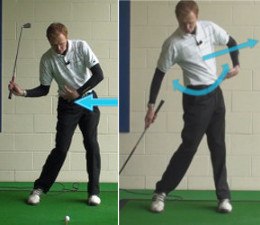
Your hips play a significantly different role in the backswing as compared to the downswing. During the backswing, your hips only provide support, helping you to maintain your spine angle and a balanced, athletic stance. It is during the transition from backswing to downswing when the hips really jump into action and take over the swing. Learning how to time that transition, and how to sequence your movements so that you can maximize their effect, is your main challenge. It is crucial that you can not only rotate your hips fully in the downswing, but that you can also do it at exactly the right moment to allow the rest of your swing to stay on track.
One of the best ways for a golf teacher to evaluate a golf swing is to watch the way the hips are used. If a player uses his or her hips effectively during the swing, that player is on the right track – even if other fundamentals need to be corrected. On the other hand, if the hips don’t play much of a role in the swing at all, the teacher will know that significant work needs to be done.
In this article, we are going to discuss the role that hip action plays in the golf swing. How should you be using your hips when swinging the club? What kinds of hip errors are common in the amateur game? We’ll look at these questions and plenty more in the content below.
All of the content below is written from the perspective of a right-handed golfer. If you happen to play left-handed, please take a moment to reverse the directions as necessary.
— The Goal
Let’s get started on this topic by outlining exactly how your hips are supposed to work during the golf swing. Even if you are nowhere near this ideal technique right now, it will help you understand how your hips should be working so you can identify mistakes and get to work on solutions. And, if you are struggling with your hip action right now – don’t worry! Plenty of other golfers are in the same boat, so there is no reason to feel bad about your performance. Instead of getting down on yourself, just make a plan and get to work on making progress.
The points below touch on the major keys related to hip action in the golf swing.
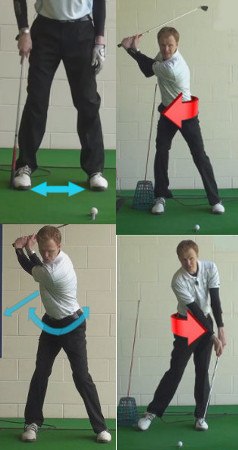
- Stability in the backswing. The main role of your hips is the backswing is to do nothing other than help support the rotation of your upper body. For the most part, your hips are going to remain stable as you swing back, while your knees stay bent and your shoulders do the work of turning the club away from the target. Of course, it’s rather difficult to make a big shoulder turn without letting your hips rotate a little, so don’t worry much about a bit of hip turn on the way back – that is to be expected. As long as you are mostly stable from the hips down, and your lower body is doing the job of supporting your upper body nicely, you should be in good shape when you get to the top of the swing.
- Square at address. Backing up a bit for a moment, it’s important to get your hips into a square position at address (or as close as you can get to that position). By starting square, you will have a couple of advantages as compared to starting with your hips open or closed. For one thing, it will be easier to swing the club directly back on the target line, which is always a good start toward solid ball striking. Additionally, it should be easier to be stable during the backswing when you start out from a solid, square position. If you are too open or closed at address, there may be extra movement in your lower body during the backswing – and that is only going to complicate your overall technique. Spend some time practicing your address position and you should gradually get more and more comfortable with what it feels like to be square when you start your swing.
- Fire from the top. It is during the transition from backswing to downswing that the hips really start to get involved in the swing. As the club approaches the top of the swing, you will fire your hips open toward the target to change the direction of the swing and start to build momentum for a powerful strike. This is a point that countless amateur golfers get wrong, and they pay the price in terms of low swing speed and poor contact with the ball. Many golfers start the downswing with their hands instead of their hips, and that is always going to be a recipe for trouble. If you can teach yourself to use your hips to start your downswing, the game will suddenly get much easier. It may help to think specifically about using your left hip to get going from the top. Think about turning that left hip open to the left, rather than sliding it toward the target. There will be a little bit of natural lateral movement as a result of your rotation, but it is the rotation of your hips that should be the main objective. When the swing is working nicely, your hips will clear through the hitting area first, and the arms and club will follow after. This creates something of a ‘whip’ effect, where your arms and the club are able to gain speed as a result of what the lower body has done to get things moving.
- All the way through to the finish. It’s great to successful fire your hips at the top of the swing, but that move will only pay off if you commit to that hip rotation all the way through the downswing. Some players back off on their rotation as impact approaches, allowing the arms to finish the job while the hips slow up. This is a mistake, and it can lead to a number of problems in the swing. Instead of giving up on your swing prematurely, keep turning all the way through and aim for a full, balanced finish. You know that pretty pose that most professional golfers strike as they watch the ball fly off into the distance? You should be striving for the same finish position and turning your hips all the way through impact will help you make it happen. It might seem that the finish position is not important, since the ball is already gone, but it serves as an important indication that you have used your body correction during the swing. If you get all the way to a balanced finish, and can hold that position, there is a good chance that the technique leading up to that finish was pretty solid.
| GOLF FIXES BY PGA PROS |
|---|
| The Correct Way to Clear the Hips to Cure Accuracy and Distance Problems | Video | Article |
| How to Clear your Hips to Help with Accuracy and Distance | Video | Article |
| What Is Stopping You Clearing Your Hips In Your Downswing | Video | Article |
| Narrow Golf Stance For Better Hip Turn | Video | Article |
| Cure and Fix Women Golf Tip – Build a Basic Hip Turn | Video | Article |
| Why Open Up Left Hip or Left Foot | Video | Article |
| Fast Down Swing Hip Turn To Generate More Club Head Speed Golf Swing Tip | Video | Article |
| Signs Of Poor Hip Alignment In A Golf Swing | Video | Article |
| How To Create The Best Golf Hip Turn | Video | Article |
| Signs Of Poor Hip Alignment In A Golf Swing | Video | Article |
| Changes Of Golf Stance Width Changes Hip Turn | Video | Article |
| Check Your Current Golf Swing Hip Position | Video | Article |
| LESSONS |
|---|
| Getting The Hips Cleared During The Golf Downswing | Video | Article |
| Distance Vs Accuracy When Opening Up The Hips During The Golf Set-Up | Video | Article |
| Getting The Hips Cleared During The Golf Downswing | Video | Article |
| Should You Bend from the Waist, or the Hips? Golf | Video | Article |
| Getting Your Hips In The Correct Position For Golf | Video | Article |
| Shoulders Then Hips During The Golf Backswing | Video | Article |
| Getting Your Hips Set For Golf | Video | Article |
| The Advantage Of Having Your Hips Open In Your Golf Swing | Video | Article |
| Golf Swing Tip: Clear the Hips for Power, Accuracy | Video | Article |
| The Best Ways To Turn Your Hips In Your Golf Swing | Video | Article |
| Henrik Stenson: Hips Shift Left Before Arms Finish Backswing | Video | Article |
| Time For Your Hips To Shine In The Golf Downswing | Video | Article |
| Hips Should Be Open At Golf Impact But What About Address | Video | Article |
| Turn Your Hips To Create An Unstoppable Force In Your Golf Swing | Video | Article |
| Golf Hip Turn, How To Best Turn Your Hips | Video | Article |
| Hips Should Be Open at Impact, But What About Address? | Video | Article |
| How The Hips Should Move From The Top Of | Video | Article |
| Control Your Hips | Video | Article |
| Correctly Move Your Hips In The Downswing | Video | Article |
| How To Hips Are Set During The Golf Short Game | Video | Article |
| Move Your Hips Through Impact | Video | Article |
| How Your Hips Should Work In The Back Swing | Video | Article |
| How To Use Your Hips To Facilitate A Full Golf Backswing | Video | Article |
| Fast Hips Equals Straight Long Golf Shots | Video | Article |
| Do You Struggle To Clear Your Hips In | Video | Article |
| Moving Your Hips From Square To Open In | Video | Article |
| Keeping the Hips in Check on the Downswing | Video | Article |
| Clearing The Hips To Help With Golf Accuracy And Distance | Video | Article |
| The Function Of The Golf Hip Turn | Video | Article |
| Hunter Mahan And His Superior Hip Rotation Golf Swing | Video | Article |
| The Sequence Of The Hip Movement During | Video | Article |
| The Hip Turn In The Golf Short Game | Video | Article |
| Golf Hip Rotation, Proper Swing | Video | Article |
| The Left Hip In The Golf Backswing | Video | Article |
| Golf Hip Term Starts With A Correct Stance | Video | Article |
| What Will You Gain With Good Hip Turn In Your Golf Swing | Video | Article |
| The Mechanics Of A Good Hip Turn In | Video | Article |
| Perfect Top Position Using Correct Golf Hip Turn | Video | Article |
| Why Stabilization Will Help Your Golf Hip Turn In The Back Swing | Video | Article |
| Lead Foot Helps Turn Hip's | Video | Article |
| Golf Pro Hunter Mahan: Superior Hip Rotation | Video | Article |
| Golf Stretch 9 – Hip rotations | Video | Article |
| Does The Left Hip Move Upwards In The Down Swing Golf Swing Tip | Video | Article |
| Proper Hip Spin | Video | Article |
| Golf Tip on Proper Hip Alignment | Video | Article |
| Senior Golf Tip – The Basic Hip Turn To Help Shoulder Rotation | Video | Article |
| Does The Left Hip Moved Upwards In The Down Swing | Video | Article |
| Golf Wedge Play, Open Lead Foot And Hip for Better Shots | Video | Article |
| Bill Haas Pro Golfer: Efficient Hip Rotation Keys Solid Ballstriking | Video | Article |
| Finding Your Own Perfect Golf Hip Turn | Video | Article |
| Changes Of Golf Stance Width Changes Hip Turn | Video | Article |
| Golf Hip Turn, How To Best Turn Your Hips | Video | Article |
| Check Your Current Golf Swing Hip Position | Video | Article |
| Hip Rotation On The Way Back And The Way Through | Video | Article |
| Golf Wedge Play, Open Lead Foot And Hip for Better Shots | Video | Article |
| Fast Down Swing Hip Turn To Generate More Club Head Speed Golf Swing Tip | Video | Article |
| Bill Haas Pro Golfer: Efficient Hip Rotation Keys Solid Ballstriking | Video | Article |
| Finding Your Own Perfect Golf Hip Turn | Video | Article |
| Golf Hip Turn, How To Best Turn Your Hips | Video | Article |
| Hip Rotation On The Way Back And The Way Through | Video | Article |
| T Hip Rotations To Get The Hips Strong | Video | Article |
| PRACTICE DRILLS |
|---|
| Strike the Golf Ball Better. Drive The Hips, Tour Alignment Sticks Drill | Video | Article |
| Right Hand Golf Tip: How the Hips Should be at Address and Impact | Video | Article |
| Improve Hip Clearance Golf Drill – Plank The Leg Up | Video | Article |
| GOLF QUESTIONS |
|---|
| Golf Hip Turn, Where Should My Hips Be When I Hit The Ball? | Video | Article |
| Golf Hips, How Can Hip Alignment Effect Shots? | Video | Article |
| What Does The Term Clearing The Hips Mean In My Golf Swing? | Video | Article |
| What Should My Hips Do During My Golf Swing? | Video | Article |
| What Should I Focus On To Create Perfect Hip Rotation In My Golf Swing? | Video | Article |
| Golf Hip Turn, Where Should My Hips Be When I Hit The Ball? | Video | Article |
| Will restricting my hip turn increase my power? | Video | Article |
| Golf Hips, How Can Hip Alignment Effect Shots? | Video | Article |
| GOLF EXERCISES |
|---|
| Semi Splits Position For Hips and Groin | Video | Article |
| T Hip Rotations To Get The Hips Strong | Video | Article |
| Hip Raise And Turn For Hip and Groin Stretch | Video | Article |
| Single Leg Hip Bridge Hip Turn Power | Video | Article |
| Golf Hip Flexor Stretch | Video | Article |
| Pre-Round Hip and Back Stretch | Video | Article |
| Level Hip and Shoulder Turn | Video | Article |
| Pre-Round Hip Stretch | Video | Article |
| Pre-Round Kneeling Hip Stretch | Video | Article |
| Back Leg Raise With Side Split For Hip Rotation and Power | Video | Article |
| Side Lift For Hip Power | Video | Article |
| Half Split for Groin and Hip Rotation | Video | Article |
| Hip Crossovers For Turn Power | Video | Article |
| Single Leg Core Twists For Hip Strength | Video | Article |
| T Hip Rotations To Get The Hips Strong | Video | Article |
| Back Leg Raise With Side Split For Hip Rotation and Power | Video | Article |
| Side Lift For Hip Power | Video | Article |
| Half Split for Groin and Hip Rotation | Video | Article |
| Hip Crossovers For Turn Power | Video | Article |
| Single Leg Core Twists For Hip Strength | Video | Article |
The good news regarding hip action is that the idea is simple. You want to keep your hips quiet during the backswing as they support your upper body rotation. Then, they should fire from the top of the swing all the way down through impact and into the finish. It’s an easy formula to understand, and it is powerful when executed properly. So, what’s the bad news? It’s going to take some time to master this move. It might sound simple but putting it into action is not as easy as you might think or hope. Give yourself plenty of practice time and be patient as you try to improve your hip action.
— Common Hip Action Problems
We touched quickly on some common hip action problems in the previous section, but we’d like to expand that discussion here to give you a better idea of what may be going wrong when you try to incorporate your hips into the golf swing. As you read these points, think about your own swing to determine if you are guilty of any of these faults.
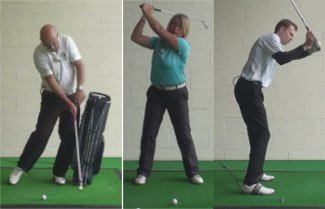
- Slide in the backswing. This just might be the most common of all the issues we will present on this list. When your backswing starts, you need to be careful to avoid the mistake of sliding to the right along with the club. This is an easy habit to get into, and unfortunately, a hard one to break. Remember, you want to keep your hips relatively stable as the backswing develops, rather than allowing them to move laterally (or rotate too much). To check whether or not this is a problem for you, try making a pretend backswing in front of a mirror without a golf club. Stand facing the mirror, take your stance, and swing your arms up to the top of the backswing. Did your hips slide to the right as the swing started? If so, you’ll know exactly what you need to work on in your swing. This kind of lateral hip slide is common among golfers who struggle with a slice, so don’t be surprised if you have a slice pattern in your game while dealing with this issue.
- Inactivity at the top. If the first point on our list is the most common mistake related to hip action, this point is a close second. When some golfers get to the top of the backswing, they don’t do anything at all with their hips – they just use the hands and arms to change the club’s direction and bring it back down toward the ball. There are a number of problems with this swing method. For one thing, it won’t develop much power, as the rest of the body won’t be able to get into the action to help accelerate the club. Also, when your hips don’t move, you don’t really clear your body out of the way to make space for the club to come down. As a result, the club is often forced ‘over the top’, or up and away from the body. That puts the club too high and too far outside the intended swing path. From there, you’ll be left to hit weakly across the ball at impact, and a slice is the inevitable outcome (with an occasional pull tossed into the mix). If you can learn how to get your lower body moving at the top of the swing, you can not only add power to your downswing, but it will become easier to swing down on the right path.
- Giving up on the turn. We mentioned this in the previous section, and we’ll take another look at it here because it is so important. Most of the time, when golfers give up on their hip rotation on the way down toward the ball, it’s due to a lack of confidence more than anything else. As you start to swing the club down toward the ball, you may feel like something is going to go wrong – so you give up a bit on the turn as you try to guide the club into impact. It should go without saying that this tentative approach rarely turns into anything good. Most of the time, you’ll make poor contact with this type of swing, and you certainly won’t hit the ball with any authority. While it’s always hard to find confidence in this difficult game, the key is to remember that there is nothing you can do to ‘fix’ your swing once you are through the transition anyway. Once the club has started down, your best bet is to commit fully to the swing and hope the shot comes off as you imagined. Not every shot will work out, of course, but committing to the swing and trusting yourself is going to lead to the best results in the end.
There is a fair chance that you are guilty of at least one of these swing mistakes from time to time, if not on a consistent basis. If you are struggling with one of these errors, there is no sense is just hoping it will go away on its own. Rarely do you improve in this game without taking the initiative to work on a solution. Get down to work as soon as possible so you can start building the foundation of a reliable swing.
— Two Hip Action Drills
If you are going to make progress on your hip action, it will be helpful to use some drills during your practice sessions. Drills are important because they give you a chance to feel what it is you are trying to accomplish during the swing. It’s one thing to know what you are trying to do, but it’s another thing entirely to actually get it done. By feeling how you are supposed to use your hips, through the help of some drills, you may be able to make more progress.
Below we have listed two simple drills that can help to point you in the right direction.
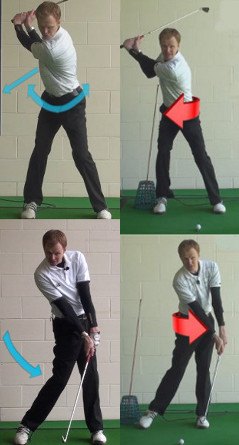
- Start from the top. This is an excellent practice swing drill that will hopefully teach you how to use your hips to start the downswing. You aren’t going to be hitting any balls while doing this drill, so you can do it anywhere you have enough space to safely make some swings. Any of your clubs will work for the purposes of this drill, but a short or mid-iron would be best. To get started, take your normal stance and move the club up to the top of the backswing. Stop at the top of the backswing and hold that position for a moment or two. When you are ready to make the swing, start the downward action by turning your left hip to the left and rotating your lower body through the shot. As your lower body turns, your upper body should follow along until the club whips down through the hitting area and up into the finish. Feel free to repeat this process as many times as you would like. Since you are starting cold from the top, rather than making one continuous motion for your swing, you should get a better feeling for how the hips start the downswing action. Then, when you go back to making normal swings, you’ll hopefully be able to continue on using your hips in an effective manner.
- Foot wedge. For this drill, we are not talking about the kind of foot wedge you use to knock the ball out of the trees while your playing partners aren’t looking. Instead, we are talking about wedging something under your foot in order to restrict any sliding action that might be taking place in your backswing. This is another drill that you can perform anywhere you have room to make swings, as it is not necessary to actually hit any shots. To get ready for the drill, you’ll need a club to swing and a small towel that you can roll up and use as your ‘foot wedge’. Place the rolled-up towel under the outside of your right foot as you take your stance. Then, when you start your backswing, you should feel that towel working to keep your hips (and the rest of your body) from sliding to the right. Make a few practice swings this way before moving the towel and making a few more swings with a normal setup.
Consistent, purposeful practice is the best way to improve at this game. It’s not good enough to just wander out to the range and hit some shots – you need to know exactly what you are working on each time you set out to practice. We hope these two easy drills will point you in the right direction with regard to improving your hip action.
— The Hips in the Short Game
It’s fair to say that your hips don’t have to do as much work in the short game as the long game. That’s not a surprise, of course, since you aren’t hitting the ball very far in the short game and you don’t need to make long swings for these short shots. However, you can’t just ignore your hips completely, as they can still help you produce good results. Let’s quickly look at a few key points in this area.
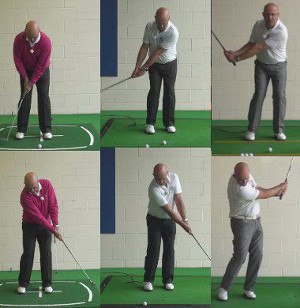
- Square during the putting stroke. When hitting putts, you want to start with your hips square to the target line – and you want to keep them perfectly still as the stroke takes place. There shouldn’t be any movement in this part of your body during the stroke, as even minor movements can send the putter off-track. Practice getting your body, including your hips, into a square position over the ball at address and you might be surprised to find how many more putts find the bottom of the cup.
- Slightly open for chip shots. When hitting basic chip shots from around the greens, you don’t need to do anything with your hips during the shot – but you should start with them in a slightly open position. Take a stance that has your feet a bit open to the target, and then match up your hips with the positioning of your feet. From there, you’ll be able to swing the club slightly across the ball at impact, which will help your chip shots get airborne with ease. Also, this stance will make it easier for you to get a good look at the target from your address position, which is helpful when chipping.
- Restrict hip turn on bunker shots. When playing a greenside bunker shot, you might be tempted to get your hips involved in the action since you’ll be using such a big swing. That does make some sense, but it is probably the wrong way to proceed. Instead, try to restrict your hip movement while making a big arm swing to slide the club into the sand and under the ball. If you move your hips too much during this kind of swing, it will be hard to place the club into the sand at exactly the right spot, and you might hit the shot thin or fat as a result. Keep your hips quiet and trust your shoulder turn and arm swing to get the job done.
Improving the way your hips work in the golf swing is not going to be easy, but it will be rewarding when the quality of your ball striking takes a step forward. Using your hips properly will help you generate more speed, strike the ball more consistently, etc. Take some time to work on this element of your technique during practice and hopefully the fruits of your labor will show up on the course sooner rather than later. Good luck!






